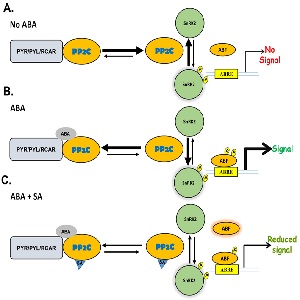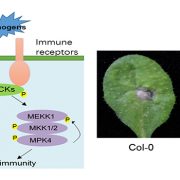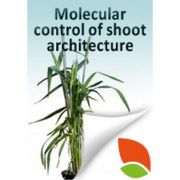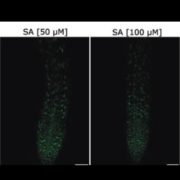Members of the abscisic acid co-receptor PP2C protein family mediate salicylic acid-abscisic acid crosstalk
 If we know anything about how ABA regulates plant response to environmental stresses it is that the pathway if very complicated and anything but straightforward. The ‘core’ ABA pathway is activated by first inhibiting a specific class of protein phosphatases, PP2Cs. This inhibition of PP2Cs allows for activation of downstream factors and induction of the ABA pathway. PP2Cs have several clades, with each clade having specific functions, regulating both stressed and non-stressed conditions. ABA enhances plant susceptibility to pathogen invasion by suppressing immune responses, , and inhibits salicylic acid(SA)-induced gene expression. SA is a hormone well characterized in enhancing plant immune response whereas ABA suppresses immune response while enhancing plant susceptibility to pathogen invasion. Manohar et al. investigate the trade-off in regulating these two antagonistic hormone pathways: ABA or SA. SA was found to inhibit ABA-induced gene expression. The authors identified a novel SA binding protein in the Clade D PP2Cs that ABA also binds. ABA and SA binding to PP2C results in a game of inhibitions where SA inhibits canonical ABA inhibition of PP2Cs. The data provided supports a model in which SA helps to stabilize PP2Cs, acting against the role of ABA in promoting degradation via proteolysis of PP2Cs. This enhances our understanding of the extensive crosstalk between hormones during environmental stresses while also adding more complexity and variability to what is known to be a very complex process. (Summary by Alecia Biel) Plant Direct. 10.1002/pld3.20.
If we know anything about how ABA regulates plant response to environmental stresses it is that the pathway if very complicated and anything but straightforward. The ‘core’ ABA pathway is activated by first inhibiting a specific class of protein phosphatases, PP2Cs. This inhibition of PP2Cs allows for activation of downstream factors and induction of the ABA pathway. PP2Cs have several clades, with each clade having specific functions, regulating both stressed and non-stressed conditions. ABA enhances plant susceptibility to pathogen invasion by suppressing immune responses, , and inhibits salicylic acid(SA)-induced gene expression. SA is a hormone well characterized in enhancing plant immune response whereas ABA suppresses immune response while enhancing plant susceptibility to pathogen invasion. Manohar et al. investigate the trade-off in regulating these two antagonistic hormone pathways: ABA or SA. SA was found to inhibit ABA-induced gene expression. The authors identified a novel SA binding protein in the Clade D PP2Cs that ABA also binds. ABA and SA binding to PP2C results in a game of inhibitions where SA inhibits canonical ABA inhibition of PP2Cs. The data provided supports a model in which SA helps to stabilize PP2Cs, acting against the role of ABA in promoting degradation via proteolysis of PP2Cs. This enhances our understanding of the extensive crosstalk between hormones during environmental stresses while also adding more complexity and variability to what is known to be a very complex process. (Summary by Alecia Biel) Plant Direct. 10.1002/pld3.20.









